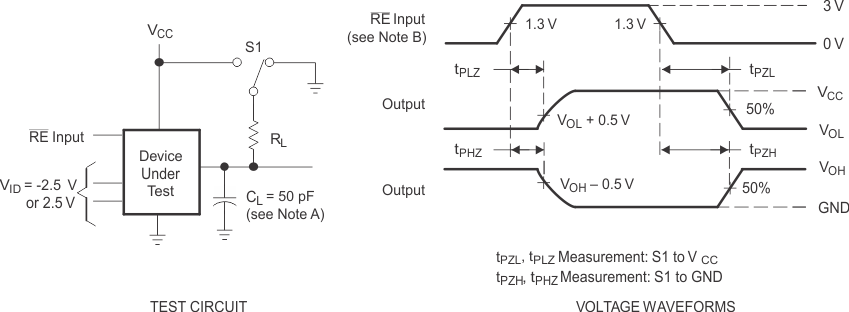SLLSFC4 July 2019 SN65C1168E-SEP
PRODUCTION DATA.
- 1 Features
- 2 Applications
- 3 Description
- 4 Revision History
- 5 Pin Configuration and Functions
- 6 Specifications
- 7 Parameter Measurement Information
- 8 Detailed Description
- 9 Application and Implementation
- 10Power Supply Recommendations
- 11Device and Documentation Support
- 12Mechanical, Packaging, and Orderable Information
Package Options
Mechanical Data (Package|Pins)
- PW|16
Thermal pad, mechanical data (Package|Pins)
Orderable Information
7 Parameter Measurement Information
 Figure 1. Driver Test Circuit, VOD and VOC
Figure 1. Driver Test Circuit, VOD and VOC 
A. C1, C2, and C3 include probe and jig capacitance.
B. The input pulse is supplied by a generator having the following characteristics: PRR = 1 MHz, duty cycle = 50%, tr = tf ≤ 6 ns.
Figure 2. Driver Test Circuit and Voltage Waveforms 
A. C1, C2, and C3 include probe and jig capacitance.
B. The input pulse is supplied by a generator having the following characteristics: PRR = 1 MHz, duty cycle = 50%, tr = tf ≤ 6 ns.
Figure 3. Driver Test Circuit and Voltage Waveforms 
A. C1, C2, and C3 include probe and jig capacitance.
B. The input pulse is supplied by a generator having the following characteristics: PRR = 1 MHz, duty cycle = 50%, tr = tf ≤ 6 ns.
Figure 4. Driver Test Circuit and Voltage Waveforms 
A. C1, C2, and C3 include probe and jig capacitance.
B. The input pulse is supplied by a generator having the following characteristics: PRR = 1 MHz, duty cycle = 50%, tr = tf ≤ 6 ns.
Figure 5. Receiver Test Circuit and Voltage Waveforms 
A. C1, C2, and C3 include probe and jig capacitance.
B. The input pulse is supplied by a generator having the following characteristics: PRR = 1 MHz, duty cycle = 50%, tr = tf ≤ 6 ns.
Figure 6. Receiver Test Circuit and Voltage Waveforms